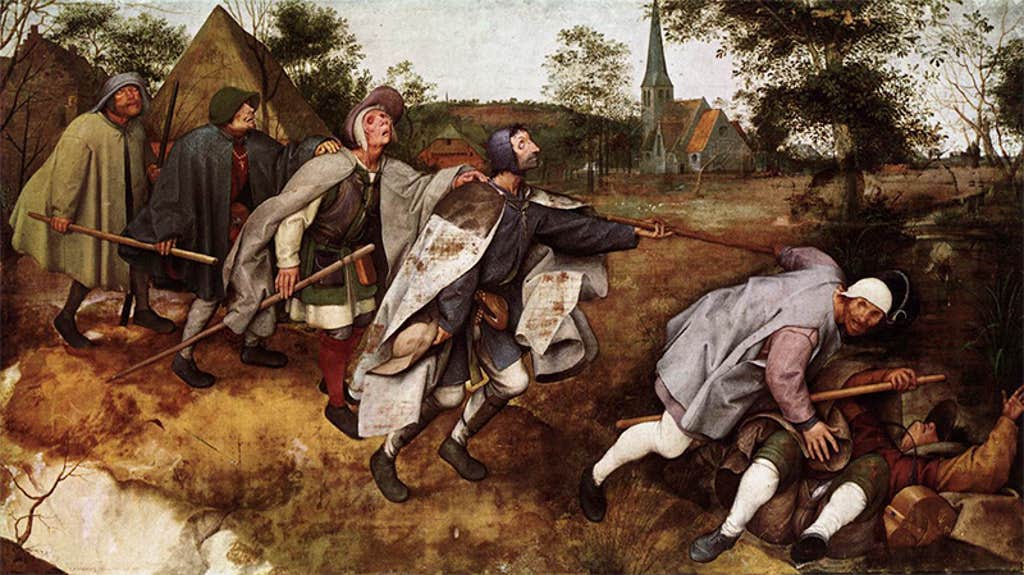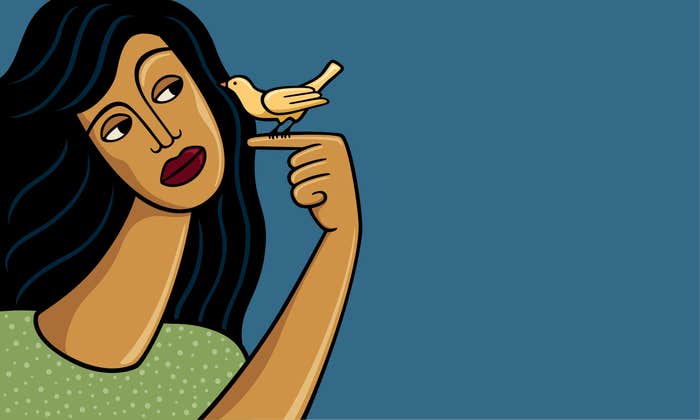I’m going blind as I write this. It feels less dramatic than it sounds. The words aren’t disappearing as I type. I’m sitting comfortably in the sunroom. The sun is rising like it’s supposed to. I can plainly see Lily sitting next to me, reading in her striped pajamas. The visible world is disappearing, but it’s not in a hurry. It feels at once catastrophic and commonplace—like reading an article about civilization’s imminent collapse from the climate crisis, then setting the article down and going for a pleasant bike ride through a mild spring morning.
There’s no cure for retinitis pigmentosa (RP), the condition I was diagnosed with more than 20 years ago, so I usually see my eye specialist every other year. During my last visit, she showed me an illustration of how much vision I had left.
There are as many ways of being blind as there are of being tall, or sick, or hot.
It reminded me of ice cubes melting in hot water: two small, wobbly ovals in the center, and two skinny shapes floating along the sides. The wobbly ovals represented the central vision I still had, and the strips were my peripheral vision. I had about 6 percent of what a fully sighted person sees. My doctor frowned graciously as she gestured at the skinny french fry shapes. “When those go,” she said in her medical deadpan, neither cheerful nor grim, “your mobility will become more limited. Those two strips of residual peripheral vision are what you’re using to get around.”
Describing what I can’t see is surprisingly difficult, mostly because my brain adapts to it so quickly. I have severe tunnel vision, but what I see doesn’t look like a tunnel; the walls of the enclosure aren’t visible.
I have the strongest sense of the contours of my blindness in periods when my vision changes—when suddenly there are things I don’t see that I ought to, that I saw until recently. I bump into furniture in my house that hasn’t moved in years. I’ll put a cup down for a moment and it disappears. I’ll painstakingly rake the wobbly ovals and slender french fries of my residual vision across the table’s surface again and again, and when I finally find the cup, it’s standing blamelessly in what even a few weeks ago I would have described as “plain sight.” It’s still in plain sight—it’s just that my sight is growing less and less plain.
There are as many ways of being blind as there are of being tall, or sick, or hot. But the popular view has always conceived of blindness as a totality. The blind bards wandering the countrysides of ancient Japan, China, or Europe, the blind housed in asylums in the Middle Ages, all the pupils in all the schools for the blind from the Enlightenment onward, blind beggars and lawyers, war veterans and toddlers—in the eyes of history, as well as those of most of their contemporaries, they all saw nothing. Modern dictionaries still subscribe to this sense: blindness is the antonym of vision, and connotes a destitution of sight.
What else could it mean?
Despite the poetic impulse to equate blindness with darkness, it’s rarely experienced as a black veil draped over the world. Only around 15 percent of blind people have no light perception whatsoever. Most see something, even if it isn’t very useful, by sighted standards: a blurry view of their periphery, with nothing in the middle, or the inverse—the world seen through a buttonhole.

For some, scenes come through in a dim haze; for others, light produces a shower of excruciatingly bright needles. Even those with no light perception at all have little use for the popular image of blindness as darkness: The brain cut off from visual stimulus can still produce washes of brilliant color and shape. One blind man, whose optic nerve—the connection between the eyes and the brain—had been severed, described seeing a continuously swirling (and distracting) “visual tinnitus.” The Argentine writer Jorge Luis Borges, decades into his blindness, still saw color, which sometimes disturbed him: “I, who was accustomed to sleeping in total darkness,” he said,
was bothered for a long time at having to sleep in this world of mist, in the greenish or bluish mist, vaguely luminous, which is the world of the blind. I wanted to lie down in darkness.
The arrival or encroachment of blindness gives rise to a similarly dazzling range of experiences, an efflorescence of blind varietals. There are those born blind, with no visual memories, whose brains—including the visual cortices—develop using four (or fewer) senses to construct their view of the world. Those who become blind in early childhood often retain visual memories that can contribute to an intuitive understanding of visual concepts. The late-blinded may have the most cognitive work to do, forced to relearn basic skills like orientation and information-gathering through new senses, long after their brains’ developmental plasticity has hardened. Some late-blinded adults consciously struggle to preserve their storehouses of mental images, like art conservators touching up old and fading masterpieces.
Only around 15 percent of blind people have no light perception whatsoever.
Ancient Greek had one word for totally blind people, tuphlos, and a different one, ambluôpia, for “dull-sightedness.” Ancient writers shared our modern predilection for using blindness as a metaphor for heedlessness and various other moral, intellectual, or spiritual failings. The Greeks and Romans spoke of blind ignorance, blind leadership, and the blindness of wealth and love; the Old Testament described bribery blinding its recipient, and the blindness of those who don’t heed the voice of the Lord—those who “have eyes but are blind” (Isaiah 43:8).
Bruegel’s 1568 painting The Blind Leading the Blind makes literal (and adds several participants to) the biblical proverb “If a blind man leads a blind man, both will fall into a pit.” The painting shows six blind men in a line across the canvas, each holding the shoulder or stick of the man in front of him. The blind guy at the back of the line looks like he’s doing all right. As the eye travels across the composition, though, the aspect of disaster gradually increases: The faces contort with growing confusion and distress as the men grimace and stumble, until we see the final blind man, arms and legs thrown wide, falling backward into the proverbial pit. The rest of the men are about to fall in on top of him.
Most disability histories describe the plight of blind people in these terms—as though they spent their lives in this muddy, cold pit. “Want and suffering were the rule rather than the exception and the blind were an economic liability,” Richard S. French observed in his representative study, From Homer to Helen Keller. “Toleration alone makes such abysmal beggary possible, and rarely does the blind man rise above it.” A tour through the Western canon offers a highlight reel of blind abjection: the pathetic stumbling of the cyclops Polyphemus, his eye pierced by Odysseus with timber that had been sharpened and then heated to a glowing red point; Oedipus taking long pins from his mother’s garment and plunging them into his eyes (“The bloody pupils / Bedewed his beard. The gore oozed not in drops, / But poured in a black shower, a hail of blood”); the third-century B.C. biblical story of Tobit, who goes blind after a swallow shits in his eyes, believes his wife has become a criminal to support him, and prays for death.
It wasn’t until I’d returned home after my freshman year in college that my mom decided I’d been complaining about my eyes long enough that I should get them checked out by a specialist. She got me an appointment at an eye clinic at UCLA, where I submitted to a long regimen of tests, including an ERG, which involves numbing your eyes and then attaching electrodes to your eyeballs to measure the amount of electricity your retinas are putting out in response to light. (It’s like testing the charge on a battery, but the battery is part of your face.)
When I finally met with the doctor, a soft mustachioed man named Dr. Heckenlively, he confirmed what I’d gleaned from Wikipedia’s great-uncle years earlier: I had “classic RP.”
Starlight had become too dim for me to register.
I could probably expect to maintain good vision during the day through my 20s and 30s. The night blindness would gradually become more severe, and my peripheral vision would erode. As I approached middle age, the degeneration would sharply accelerate. There is no treatment, he told me, but science is making great progress, so by the time I was really blind, in 20 or 30 years, there would hopefully be a cure. In the meantime, there were some vitamins I could take to try to prolong my useful vision. Did I smoke? Yes, of course I smoked. I also had a radio show on the college station called A Thousand Frowzy Steams. Well, the doctor told me, I’d need to quit immediately—cigarettes are terrible for ocular health. Can you see stars? he asked.
This was something I’d already noticed: Starlight had become too dim for me to register. It was also the detail that brought it all home for my mom. She sat up straight: “You can’t see stars!”
Afterward, we visited a museum downtown, where we saw a show of Richard Serra’s Torqued Ellipses—huge steel sheets rolled into standing curves set within one another, creating open tunnels. Wandering through these brief mazes, each with only two or three turns to make inside, made it feel like the shape of the whole world had changed; the world itself became a torqued ellipse, with only a strip of the outside splashing in. I felt at once claustrophobic and expansive. ![]()
Andrew Leland is a writer, audio producer, editor, and teacher whose work has appeared in The New Yorker, The New York Times Magazine, McSweeney’s Quarterly, and others. He is an editor at The Believer and hosted and produced the podcast The Organist; The Country of the Blind is his first book.
From The Country of the Blind by Andrew Leland. Reprinted by arrangement with Penguin Press, an imprint of Penguin Publishing Group, a division of Penguin Random House, LLC. Copyright © 2023, Andrew Leland.
Lead image: fran_kie / Shutterstock

























